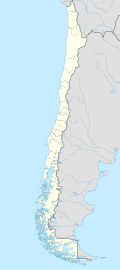Native name: Isla Guarello | |
|---|---|
 Guerello Island seen from Contreras Sound | |
| Geography | |
| Coordinates | 50°23′S75°20′W / 50.383°S 75.333°W |
| Adjacent to | Pacific Ocean |
| Administration | |
| Region | Magallanes |
| Additional information | |
| NGA UFI=-883834 | |
Guarello Island (Spanish: Isla Guarello) is an island in Madre de Dios Archipelago in Magallanes Region. Guarello Island is in a limestone area that also includes Madre de Dios Island. The island has the world's southernmost limestone mine and it has reserves for 100 years, and 600,000 tons of limestone with a millesimal fineness of 96% of Calcium carbonate are extracted each year. Half of the production is used in the steel mills of Huachipato which also owns the mines.
Contents
The origin of the quarry date back to the 1940s when Compañía de Acero del Pacífico (CAP) sought a limestone source for its steel mill in Huachipato. CAP contracted geologist Carlos Ruiz Fuller who helped identify the limestone area from aereal photographs. The establishment of a quarry in the Guarello Island was approved by CAP 1946 and after studies that concluded in 1948 works to establish the quarry begun in 1949. The first shipment of lime departed isla Guarello on March 1950. [1] Initially an underground quarry given the advesere climate in the mid-1950s the cieling collapsed turning the quarry into an open pit. [1]
